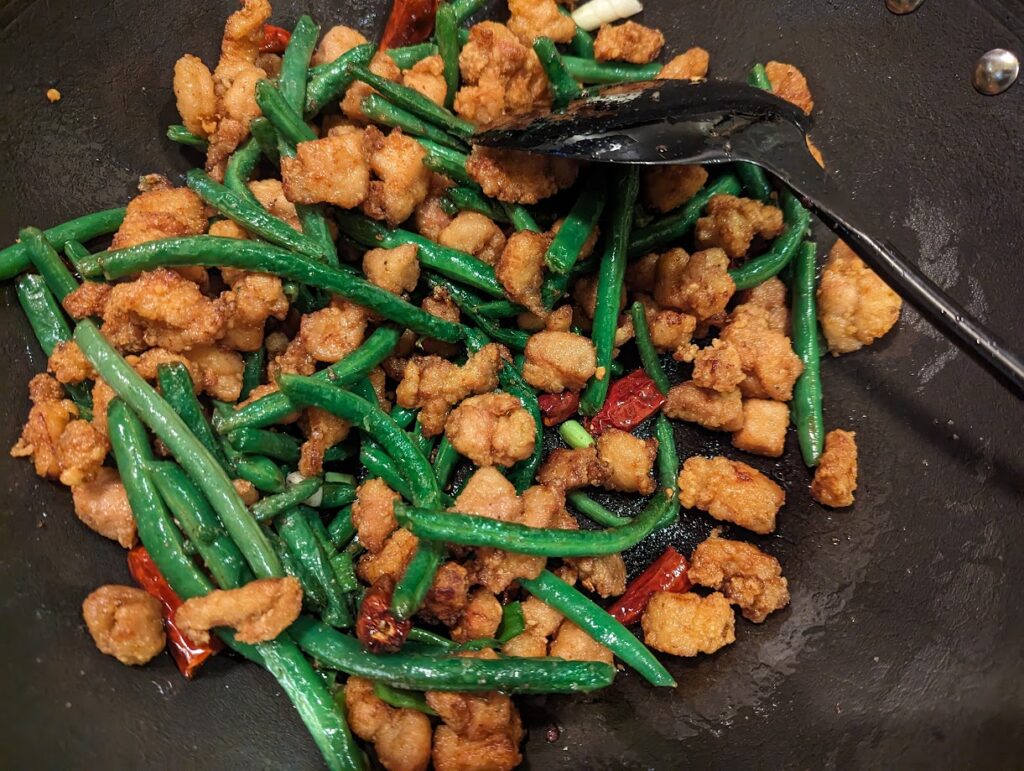
This is my version of a classic Chinese dish. While the heat can easily be increased, the recipe as written will produce a very mild level of spice (at best one star on a restaurant scale).
Ingredients
Spiced Salt
- 1 1/4 tsp Coarse Sea Salt
- 1/4 tsp Sichuan Pepper (or more to taste)
Marinade
- 1 T Shaoxing wine
- 1 T Soy Sauce
- 1 thumb sized piece of fresh ginger, washed and sliced
- 1/2 tsp Sugar (or quality substitute)
- 1/4 tsp ground chiles (or more to taste)
- 1/2 tsp of the Spiced Salt (see above)
Aromatics
- 12-16 dried Facing Heaven Chiles (adding more or cutting the peppers to use some of the seeds if a higher level of spice is desired)
- 1/4 tsp Green Sichuan Pepper
Coating
- 1/4 cup Corn Starch
- 1/4 cup Potato Starch
Meat and Vegetables
- 1.1 lbs boneless skinless chicken thighs, roughly cut into 1/4″ x 1/2″ pieces
- 12 oz Green Beans
Other Ingredients
- 1-2 cups of oil for frying (Rice Bran oil is preferable)
Preparation
Combine the sea salt and the sichuan pepper and grind until the pepper is broken up and the salt is fine rather than coarse.
Combine the ingredients for the marinade, reserving the remaining spiced salt for later.
If the chicken isn’t already cut, cut the chicken thighs and add them to the marinade. I usually buy the chicken when it is on sale, and then cut and freeze the appropriate amount to save time when cooking. Let the chicken marinate for 30-60 minutes, then remove the slices of ginger.
In another bowl, combine the coating mixtures, and then add the chicken, trying to remove as much marinade as possible before adding the chicken to the coating mix. Coat the pieces well.
Prepare a wire rack to hold the cooked chicken. I recommend lining the pan underneath the rack with paper towels to absorb any grease.
Heat the oil, ideally in a Wok (if you have gas or induction), or an enamel cast iron dish (if you have conventional electric, and need to retain more heat as you work). When the oil is shimmering, dip a small test piece of chicken in to make sure that it starts to fry immediately. Fry the chicken in batches until a light gold color, being sure not to let the oil get too hot or too cold, and then put each batch of chicken on the drainage rack.
When all of the chicken is fried, return the chicken to the oil (whether in batches or all at once will depend on the size of your cookware and the efficiency of your range) to fry it a second time, this time cooking the chicken to a deep gold color.
Fry the green beans in the oil until they are a deep green, and then remove them to the rack. Overcooking the green beans will not ruin them, but will take away any crispness.
Pour the oil off into a filtered container and wipe the residue of the frying out of your cookware, then add 2 TBS of oil back into the pan and return to the heat. Add the aromatics, and cook until fragrant (30 seconds or so, depending on the range). Once fragrant, turn off the heat, as we don’t want to scorch the aromatics. If your pan is big enough, return all the chicken and green beans to the pan and toss to coat them with the spiced oil evenly. If not, combine everything in a large bowl off the stove. Sprinkle the remaining spiced salt over the dish, and again, toss to spread it evenly. Serve immediately.
